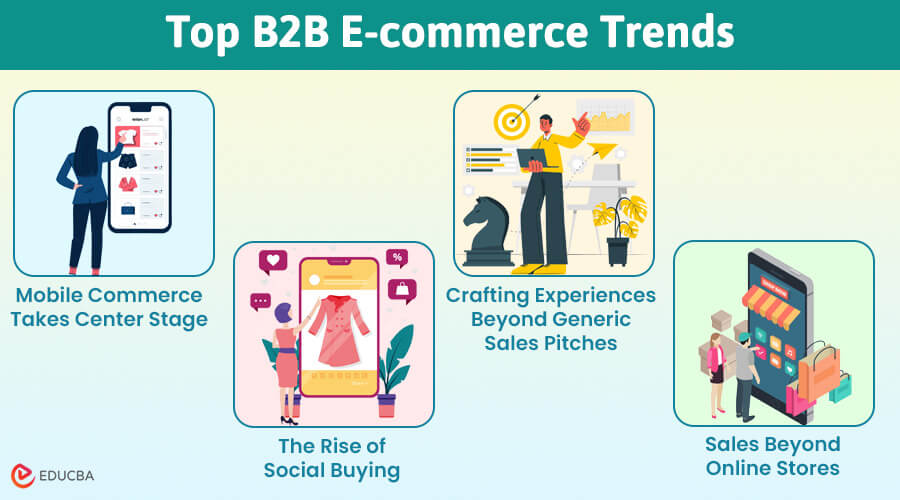
Top B2B E-commerce Trends – Introduction
As businesses increasingly embrace digital channels, understanding the latest B2B e-commerce trends is crucial. As an entrepreneur, you might have witnessed the seismic shift firsthand. Game-changers have been implementing mobile-friendly interfaces, embracing personalization, and exploring omnichannel strategies.
This comprehensive guide will explore statistics, dissect emerging patterns, and provide actionable insights.
Top 4 B2B E-commerce Trends
#1. Mobile Commerce Takes Center Stage
In our smartphone-driven era, mobile optimization is non-negotiable. Consider this: 42.9% of all e-commerce purchases will occur on mobile devices. B2B buyers are no exception—researching, comparing, and placing orders via their phones. As a business, ensure your website is responsive, load times are lightning-fast, and the checkout process is seamless. Remember, a mobile-friendly experience reduces bounce rates and boosts conversions.
#2. The Rise of Social Buying
Social media platforms—Instagram, TikTok, and Facebook—are potent sales channels. Approximately 36% of U.S. internet users are social buyers. Imagine your B2B products showcased in engaging videos or carousel ads. Optimize your presence on these platforms, explore shoppable posts, and tap into the social commerce revolution.
#3. Crafting Experiences Beyond Generic Sales Pitches
B2B buyers demand personalized interactions. Generic sales pitches won’t cut it. A McKinsey survey revealed that customers crave relevance. As a business, you can leverage data to recommend products, personalize email campaigns, and offer targeted promotions. Imagine an e-commerce site that knows your client’s preferences better than their favorite coffee order. That’s the level of personalization to aim for.
#4. Sales Beyond Online Stores
Omnichannel isn’t just a buzzword; it’s a strategic imperative. B2B buyers expect consistency across channels—browsing your website, interacting with chatbots, or attending industry events. So, ensure you sync inventory, customer data, and order history. This way, a client can start a quote on their laptop, finalize it via mobile, and receive updates via SMS. That’s the omnichannel magic.
Best Tools for B2B E-commerce Success
1. Shopify Plus
Shopify Plus is the heavyweight champion for enterprise-level B2B e-commerce. It scales effortlessly, offers deep customization, and provides advanced multichannel selling. Features like automated workflows and unlimited staff accounts empower high-volume merchants. The Merchant Success Program ensures you are never alone on this journey.
2. BigCommerce
BigCommerce’s headless architecture allows unparalleled customization. Its B2B extension caters to wholesalers. Multi-Storefront capability lets you manage multiple brands or regions seamlessly. Plus, it’s SEO-friendly—a must for visibility.
3. WooCommerce
WooCommerce, a WordPress plugin, is flexible and cost-effective. It’s ideal for smaller B2B businesses. With the right extensions, it can handle complex transactions and inventory management.
4. Alibaba
Alibaba dominates global B2B trade. It connects buyers and suppliers worldwide. If you are sourcing products or looking for international partners, explore Alibaba.
5. Amazon Business
Amazon Business is the B2B arm of the retail giant. It offers bulk purchasing, streamlined procurement, and a familiar interface.
Additional B2B E-commerce Statistics
Here are some statistics on B2B e-commerce:
- The global B2B e-commerce market might reach $56 trillion by 2028. That’s a jaw-dropping figure, emphasizing the sheer scale of B2B transactions happening online.
- A whopping 80% of B2B buyers use their mobile devices for research and purchasing during working hours.
- 65% of B2B companies in the United States offer fully digital service options.
Final Thoughts
B2B e-commerce is rapidly evolving, driven by trends such as digital transformation, AI integration, and enhanced customer experiences. Businesses are increasingly leveraging data analytics to personalize interactions and optimize supply chains. The rise of mobile commerce and the shift towards omnichannel strategies are further reshaping the landscape. As these trends continue to develop, companies that adapt swiftly and innovate will likely lead the market.
Recommended Articles
We hope you follow these top B2B e-commerce trends and optimize your business. Here are some similar articles you can read.
